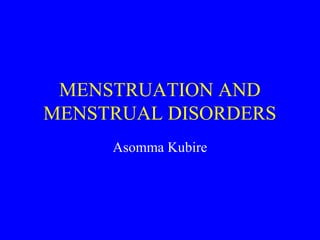
Menstruation and menstrual disorders
- 2. Objectives • Understand hormonal changes in menstrual cycle • Understand ovarian changes in menstrual cycle • Understand endometrial changes in menstrual cycle • Identify, diagnose and treat some abnormalities of menstruation
- 3. Stages of menstrual cycle • • • • • • Follicular phase (Proliferative phase) Luteal phase (Secretory phase) Cycle ranges between 25 and 32 days Menstrual flow is for 4-6 days Luteal phase lasts between 12 and 16 days Luteal phase is usually reported to be of constant duration – 14 days
- 4. Organs involved in menstrual cycle • • • • Hypothalamus Anterior pituitary Ovary Uterus (Endometrium)
- 5. Hormones in menstrual cycle • Gonadotrophin Releasing Hormone (GnRH) • Follicle Stimulating Hormone (FSH) • Luteinising Hormone (LH) • Estrogen • Progesterone
- 6. Pituitary and Hypothalamic events • Atrophy of the corpus luteum with falling progesterone and estrogen levels initiates the menstrual cycle • Low estrogen and progesterone levels cause GnRH secretion by the hypothalamus • GnRH acts on the pituitary to secrete FSH and LH • FSH initiates development of the follicles in the ovary
- 7. Ovarian events • FSH causes development of 18-20 follicles • Developing follicles produce estrogen through action of FSH and LH • One follicle becomes dominant follicle • Rising estrogen levels inhibit FSH and LH • All follicles except dominant follicle undergo atresia • Rising estrogen levels from dominant follicle cause LH surge • LH surge brings about ovulation
- 8. Post ovulatory events • Corpus luteum (CL) is formed after ovulation • CL produces progesterone and estrogen • Hormones from CL maintain endometrium until CL undergoes atresia • Atresia of CL leads to shedding of endometrium – menses- and initiation of another cycle
- 10. Hormonal Events • Negative feedback • Positive feedback • LH surge starts 34-36 hours before ovulation • Peak of LH surge is 10-12 hours before ovulation
- 11. Ovarian Events • Stages of follicle development – primordial, primary, secondary, tertiary, graafian • Recruitment of follicles • Emergence of dominant follicle • Ovulation • Corpus luteum formation
- 13. Endometrial Events • Changes are due to estrogen and progesterone • Proliferative phase is characterised by increase in growth of endometrium – primarily glandular growth • Glands are narrow and tubular with mitoses and pseudostratification
- 14. Endometrial events • Luteal phase changes are used to date the the cycle • Day 16 – pseudostratification and subnuclear vacuoles: first sign of ovulation • Day 17 – glands are tortuous and dilated • Day 18 –vacuoles are beside nuclei • Day 19 – pseudostratiication and vacuoles have disappeared
- 15. Endometrial events • Day 21,22 – edematous endometrial stroma • Day 23 – stromal mitosis starts • Day 24 – predecidual cells surrounded by spiral arterioles and numerous stromal mitoses • Day 25 – predecidual cells begin to differentiate under surface epithelium • Day27 – upper portion of endometrial stroma made up of well-diffrentiated decidua-like cells
- 16. Menstrual disorders • Dysmenorrhea • Menorrhagia • Amenorrhea
- 17. Menstrual disorders • Dysmenorrhea: Painful lower abdominal cramps occurring just before or during the menses • Primary dysmenorrhea begins at or shortly after menarche • Secondary dysmenorrhea occurs well after menarche and is associated with pelvic pathology
- 18. Menstrual disorders • Primary dysmenorrhea is due to abnormalities of prostaglandin metabolism • Secondary dysmenorrhea – pelvic infection, uterine fibroids, endometriosis, adenomyosis
- 19. Treatment of dysmenorrhea • Primary: NSAIDS and oral contraceptives • Secondary: Treatment of underlying cause
- 20. Menstrual disorders • Menorrhagia is prolonged (more than 7 days) or excessive (over 80ml) uterine bleeding occrring at regular intervals • Dysfunctional uterine bleeding: Excessive uterine bleeding with no demonstrable organic cause
- 21. Menstrual disorders • DUB is due to abnormalities of prostaglandin metabolism • Menorrhagia – gynaecolgical causes, endocrine causes, haematologic causes
- 22. Causes of menorrhagia • • • • • Uterine fibroids Adenomyosis Endometrial CA Hypothyroidism Bleeding disorders
- 23. Menstrual disorders • Amenorrhea: absence of menses during the reproductive years • Primary amenorrhea: Absence of spontaneous menses in an individual older than 16 • Secondary amenorrhea: absence of menses in an individual who has previously had spontaneous menstrual periods
- 24. Causes of secondary amenorrhea • • • • • • • • Pregnancy Anovulation PCOS Intrauterine synechiae Secondary Vaginal atresia Hyperprolactinaemia Pituitary tumours Cushing’s syndrome • Hyperthyroidism • Premature ovarian failure • Hypothalamic pituitary dysfunction • Stress • Severe weight loss • General medical disorders • Adrenal tumours
- 25. Causes of primary amenorrhea • Turner’s syndrome • CNS tumours • Androgen insensitivity (Testicular feminisation syndrome) • Hyperprolactinaemia • Congenital adrenal hyperplasia • • • • • • • • Vaginal atresia Imperforate hymen Mullerian abnormalities Hyperthyroidism Late development Stress Low body weight Adrenal tumours
- 26. Investigation of secondary amenorrhea • • • • • • • • • History and examination Pregnancy test Progesterone challenge FSH, LH assay Serum prolactin Thyroid function tests CT scan / lateral skull X-ray Hysterosalpingogram USG
- 27. Investigation of primary amenorrhea • • • • • • • • History Examination Chromosomal studies FSH, LH assay Serum prolactin CT scan USG Laparoscopy
